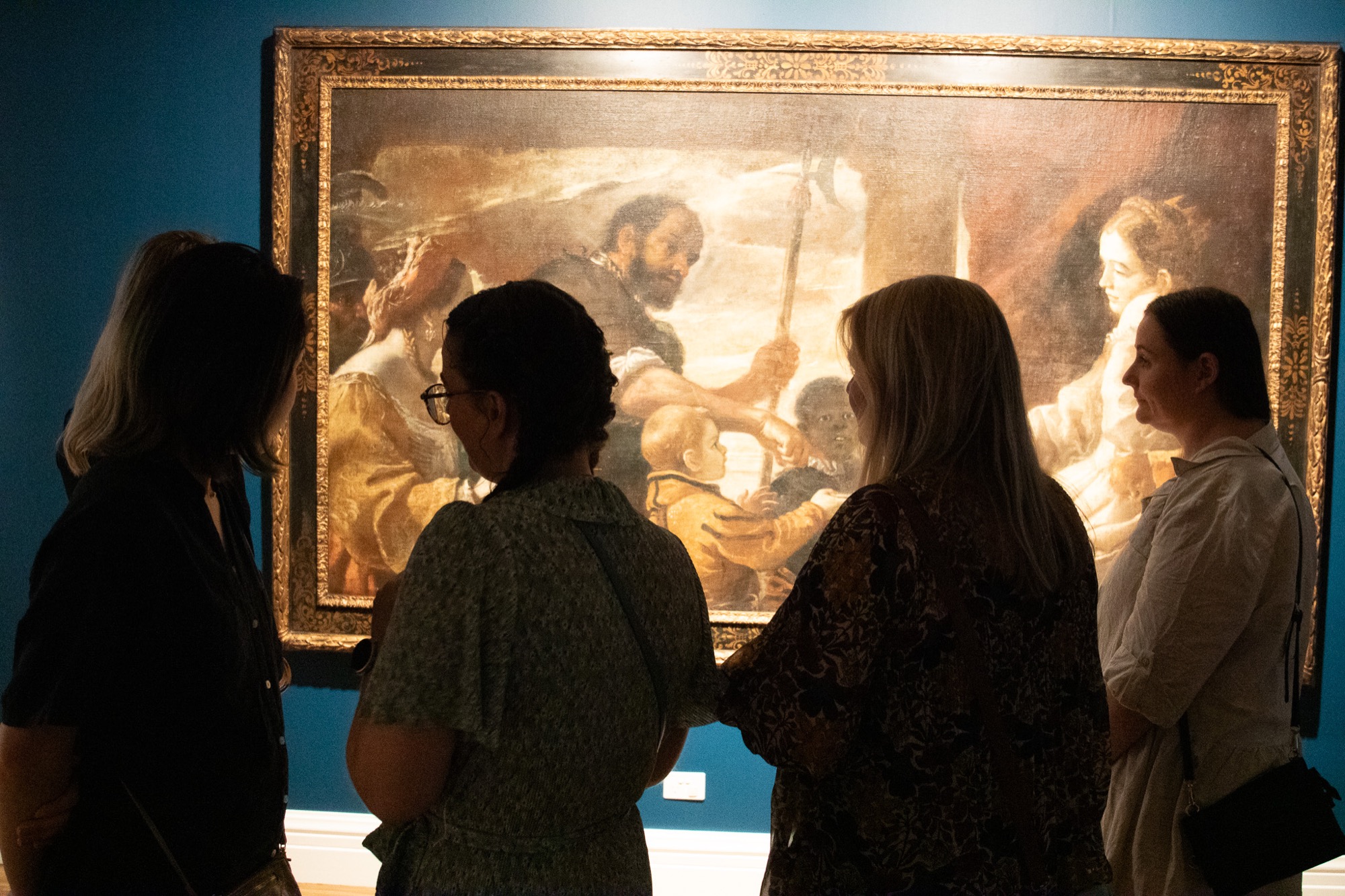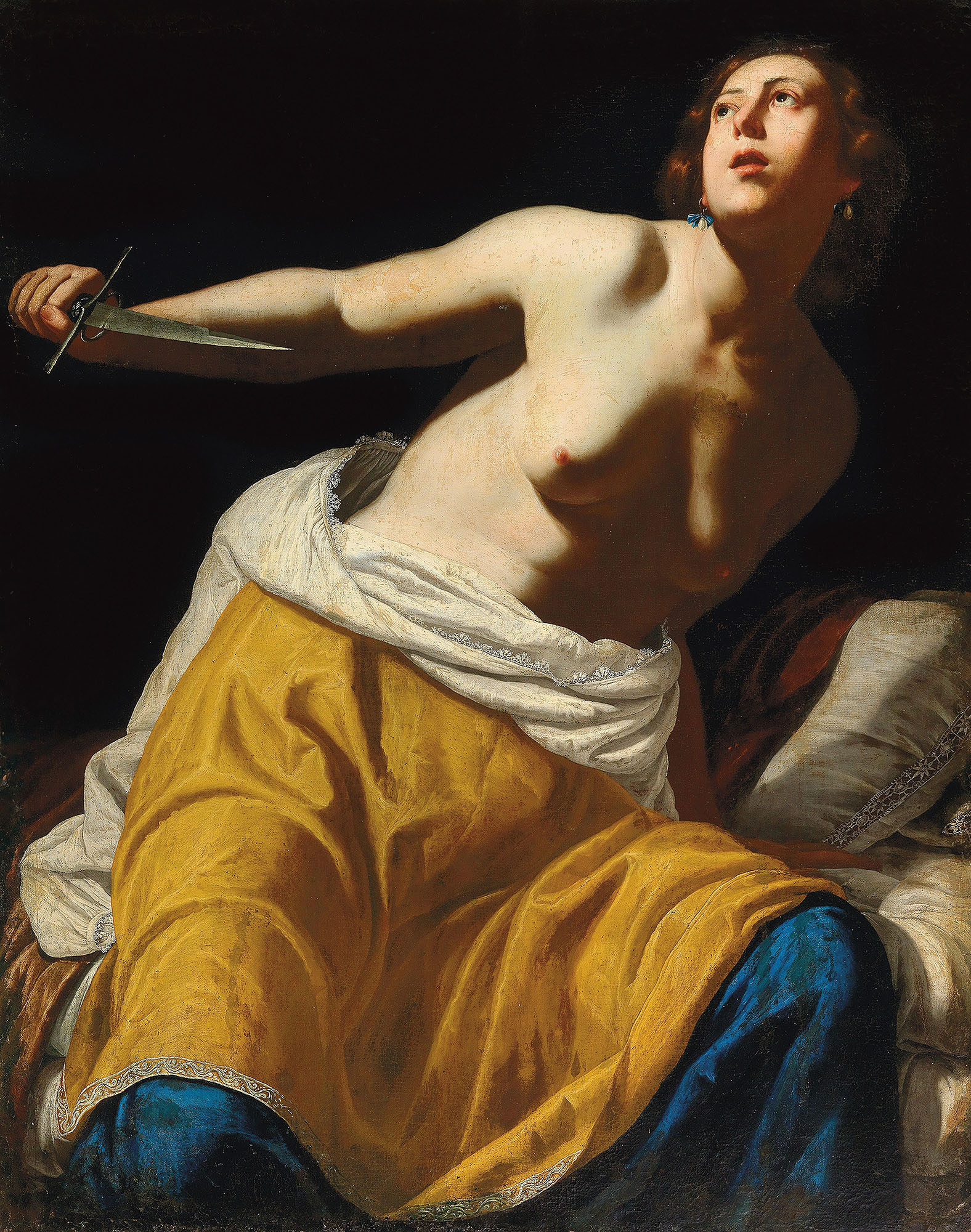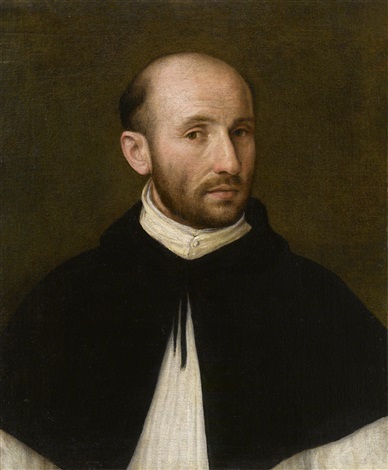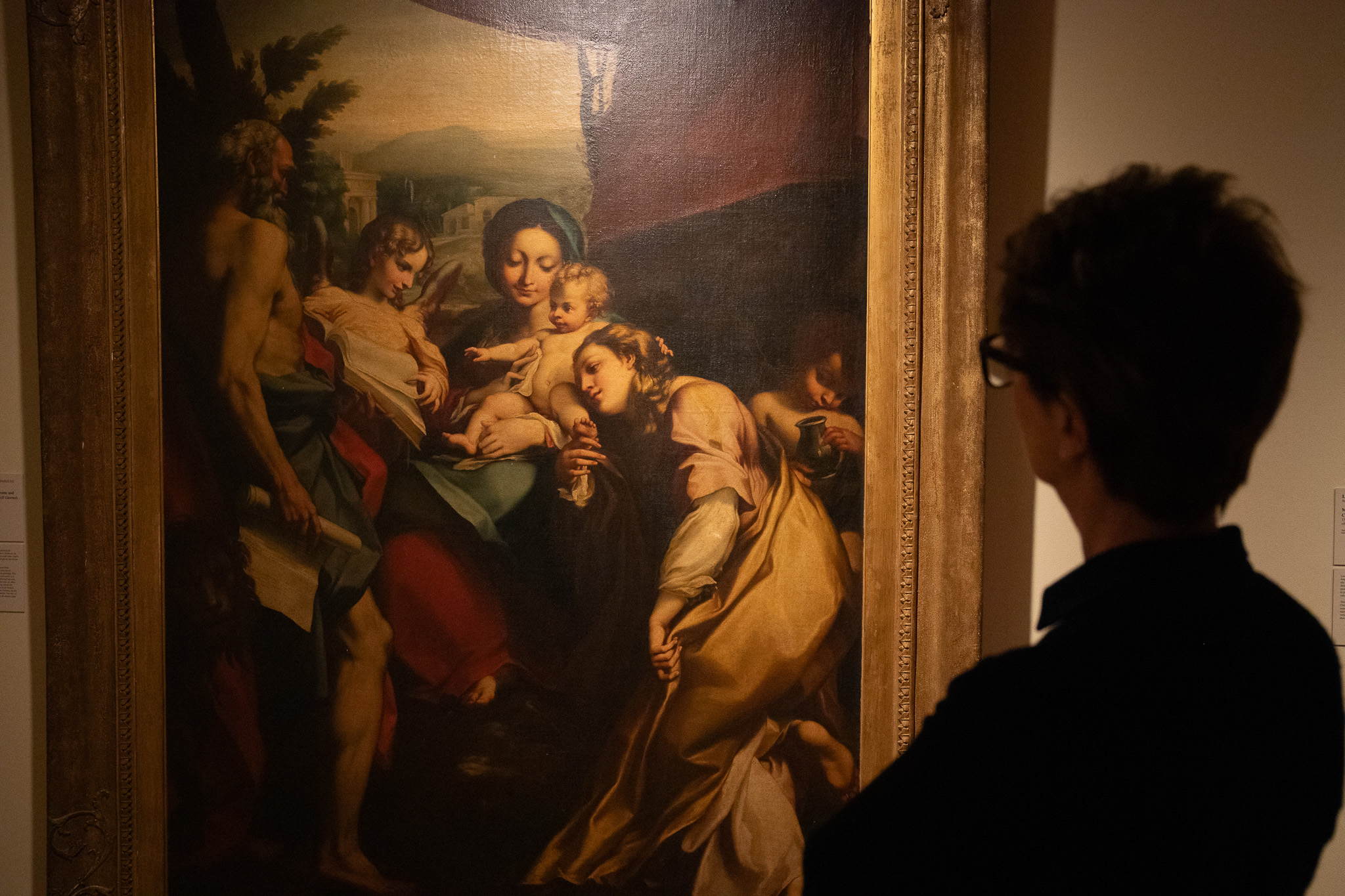Emerging From Darkness: Faith, Emotion and The Body in the Baroque
Giles Fielke
I have a lingering memory of accidentally sitting down next to Geoffrey Rush at the Melbourne International Film Festival in 2016. It was for a screening of The Death of Louis XIV by the Catalan artist-filmmaker Albert Serra. My immediate impression was that Rush had coveted the role of the King, played by aging French actor Jean-Pierre Léaud (whose acting career began in the 1950s). Of course, the antipodean actor had no real claim to a role that is the very embodiment of French imperialism. Still, I felt that there was a striking similarity between Rush and Louis / Léaud. At the time, Rush was the inaugural president of the Australian Academy of Cinema and Television Arts (AACTA); he resigned the year after my encounter with him following allegations of inappropriate behaviour while he was playing the lead role in the Sydney Theatre Company’s staging of King Lear. “L’État c’est moi,” I imagined Rush repeating to himself (linking the ancient ruler of the Britons to the almost modern Louis). The Oscar-like gold statuette for the Australian Academy was created by sculptor Ron Gomboc for the inaugural AACTA Awards in 2012, who was directed by the Academy to “incorporate the shape of the Southern Cross constellation.” How we place ourselves matters, and being in this strange proximity to Rush had revealed to me something about the structure of this projection of ourselves—back to Europe and Britain—in its twenty-first century form.
At the entrance to Emerging from Darkness: Faith, Emotion and the Body, which opened at the Hamilton Gallery on 8 December, is a tapestry based on a late design by Charles Le Brun (1619–90). Titled The Entry of Alexander into Babylon (c. 1700–25, after a design of 1688) it was manufactured in Belgium in the workshop of Judocus de Vos. Le Brun was director of the French Royal Academy of Painting and Sculpture, which he had helped establish as first painter to King Louis XIV, as well as establishing the Academy of France at Rome during the Age of Absolutism. The view from Hamilton, on the western edge of Victoria’s volcanic plain grasslands—and at the confluence of Gunditjmara, Tjap Wurrung, and Bunganditj lands—remains decidedly gothic, however, and not classical as the Academies would have it. Not gothic in the medieval sense, but in the nineteenth-century Revival Gothic tradition of Augustus Welby Northmore Pugin. It is a colonial and industrial gothic. As an architect, designer, and a Catholic dissenter from the Church of England, Pugin worked to re-design the British Houses of Parliament at the Palace of Westminster after the great tally-stick fire of 1834. It was at this same moment that Major Mitchell was surveying the regions south of the Murray River during his third expedition, and subsequently encouraged pastoralists to set up stations on the fertile, volcanic plains near Tae Rak / Lake Condah (where a mission was established in 1867) and the Budj Bim aquaculture systems of the Gunditjmara people, which were eventually recognised and added to the World Heritage Register in 2019. Readers may know this already, but as a first-time visitor to the district, I was interested to learn that Hamilton was declared a town in 1851 and a city in 1949. The Hamilton Gallery first opened in 1961, after a bequest—which included the early eighteenth-century tapestry designed by Le Brun—was left to the city by local pastoralists Herbert and May Shaw. For its sixtieth anniversary, the current artistic director of the gallery, Joshua White, describes how Hamilton Gallery “embodies the values that our founders placed and we continue to place upon these objects; it personifies our visual heritage.” There are about ten thousand objects in the collection of the gallery today. Most of these are from elsewhere, yet a scoring book from the 1868 tour of Aboriginal cricketers in England is there because most of the team was from the Western districts. A series of copperplate etchings by Keerray Woorroong Gunditjmara multi-media artist Vicki Couzens was purchased by the gallery in 2017.

Shaw had twelve siblings and is said to have descended from a Scotch-Irish family of dissident Protestants who had refused to take the Oath of Allegiance to the English Monarch as Head of the Church. This triggered waves of migration to North America and to Australia, and though raised in Melbourne, Shaw moved to Hamilton at the turn of the century and eventually married the daughter of the current Treasurer and future Premier of Victoria, Sir William McPherson, in 1923. Herbert and May Shaw had no children and travelled extensively, collecting mostly European and East Asian decorative arts. This explains, perhaps, how an interest in collecting and the aesthetics of the state developed in tandem. Perhaps as a symptom of identarian thought, there has been a religious revival in recent years, as against the perceived failures of secularisation and global modernism. The harbour of “tradition” also explains how Emerging from Darkness, the most ambitious undertaking at the regional gallery, might be perceived as a somewhat didactic blockbuster. Highlighted by the public appearance of a Lucretia portrait by Artemisia Gentileschi (c. 1630–35) from a private collection perhaps somewhere nearby to Hamilton, as it was sold at auction in Vienna for US$2.1million in 2018, the exhibition takes what it calls “Stories of Women” as its principle focus while underscoring the heroism of women before the state and before God.
The story of the rape of Lucretia and her suicide emblematises the formation of the Roman Republic (it also echoes the British myth of Queen Cordelia). The painting by Gentileschi—one of a number she made of the same subject—has not been exhibited in public for nearly four-hundred years. Depicted looking upwards at the moment of her suicide, Lucretia’s exposed breast is the central focus of the work. Contrasted to the suicide of Sophonisba, who took poison rather than be taken to Rome after the defeat of Carthage during the Second Punic War (218–201BCE), these pre-Christian myths are imbued with a sense of Christian piety in their re-imagination. This suggests to the viewer an overbearing sense of duty throughout the exhibit, from the moment of arrival amongst the tenebrism of the five contemporary works paying tribute to Baroque aesthetics, and on to the intensity of the works on display upstairs, mostly on loan from the collection of the National Gallery of Victoria (NGV). Our duty is to look in awe at history. Lovingly curated by Dr Lisa Beaven and Assoc. Prof. David Marshall, with Laurie Benson from the NGV and Ian Brilley from the Hamilton Gallery, there is also a timeline on one ground floor wall that begins with the posting of the Ninety-five Theses by Martin Luther on 31 October 1517, and which ends with the execution of the English Monarch Charles I on 30 January 1649.

There is, therefore, a sense that the contents of the exhibition—ostensibly a show about the Italian Baroque—are explained by the attempts, and failures, of the reform movements. This extends not only to Roman Catholicism but also to art. The focus on the Caracci Academy in Bologna, and the influence of Correggio from Parma establishes the predominance of chiaroscuro and the dramatic use of shade to frame the Baroque as chaotic and distinct from the preceding period of Renaissance order and symmetry. When I teach first-year university students about this period, I often make a comparison to modern-day advertising. The counter-reformation of the Catholic church after the Council of Trent had resolved in 1563 to reject the reforms and began to encourage both realism and complex, attention-grabbing, imagery to gain the support of a public seduced by sex, violence, and emotional intensity. The sensuality of Gianlorenzo Bernini’s buttery use of marble epitomises this aesthetic of display, here represented by his gilt bronze Countess Matilda of Tuscany (ca. 1634), and his bronze bust of Cardinal Richelieu (ca. 1642), with the red eminence and the countess both on loan from the NGV and both from marble originals in the Vatican and the Louvre, respectively.
The appearance of recognisable, everyday figures re-creating staged scenes from the stories of the Bible is also easily demonstrated in the work of Caravaggio at the outset of the seventeenth century. Sadly, no works by Caravaggio appear in Hamilton. However, a digital projection (somewhat inexplicable) of his Cardsharps (ca. 1595) appears in the stairwell to the upstairs galleries, seemingly to stand in for the impossibility of a Caravaggio in Hamilton. The influence of the painter is discernible everywhere, however: especially so in the incredible Martyrdom of Saint Lawrence by the Spanish artist Jusepe de Ribera from 1620–24. The implied grotesquery of the grill upon which the third-century Deacon of the Church of Rome was roasted is as brutal as the exhibition gets. A relatively recent acquisition by the NGV with funds donated by industrialist-philanthropists Allan and Maria Myers and Andrew Sisson in 2006, the work is emblematic of the Caravaggisti that also extends to the Gentileschi and Fontana families of artists, who alongside the Caracci are represented by multiple examples and members both male and female. Alongside Artemisia Gentileschi and Lavinia Fontana, the inclusion of a sixteenth-century portrait by Sofonisba Anguissola (assumedly named for the Carthaginian noblewomen) further entrenches the significance of women artists and subjects to the curation of the exhibition. Described on the exhibition website as “heroes,” there is a present anxiety throughout the exhibition that appears concerned to reassure its audience of the importance of women to Baroque society (even to the point of extolling the virtues of Artemisia Gentileschi as an authentic painter of Lucretia—a victim of rape who took her own life for the virtue of her family, city, and state—because she was notably also a victim of rape herself).

These contrasts then serve to set the grounds for an argument: what can the Baroque mean for us today? Violence, certainly. And colonialism. It is the Baroque regent, Louis XIV (1638–1715) to which all others must be compared. As the longest-serving monarch in modern history, the “sun never set” on his dominion: French colonies were established around the world during the seventeenth century (today there are more French speakers in Africa than in Europe, just as there are more English speakers outside of Britain). The polite way to describe this context for the Baroque (an adopted word from the Portuguese term for a misshapen pearl) is that it was a “global” movement. Also included at Hamilton are Parisian facsimile prints from 1977 loaned by the National Library of Australia, after the copperplate engravings of the Chinese artist Yi Lantai (active ca. 1786), depicting the garden designs for the K’ien-Long Emperor by the Italian Jesuit missionary Giuseppe Castiglione. The Italian Baroque becomes a malleable concept—allowing for the inclusion of a nineteenth-century version of Il Giorno by the High Renaissance artist Correggio (1489–1534). Here the project comes closest to revealing the link between the regional gallery and the continuing project of the religious civilising missions that stem from the fact that the reformation of the Roman Catholic church coincided with the first circumnavigation of the world by European explorers (1519–22) and the expulsion or forced conversion of the Jews in Spain by the Catholic Monarchs Ferdinand and Isabella, the European discovery of the Americas, all within the preceding three decades. In one generation the entire world was changed forever. The obvious argument to make is that we are still living the effects of the “Italian Baroque” today.

This leads me back to the antipodean intervention in these histories. How do Australian settler-capitalists, born in the twentieth century and after the Second World War, perceive their place in this world five centuries hence? The key supporters of this current endeavour, echoing the Shaw bequest six decades ago, are Allan and Maria Myers. Born in Hamilton, Allan Myers is now a Knight of Malta, the owner of the Tipperary Group of stations in the so-called Northern Territory, a civil libertarian and philanthropist (among many other things he was the previous Chancellor of the University of Melbourne). Capitalism and monarchy have an uneasy relationship, but they court each other. Power—even soft, or cultural power—has its intentions: is it the Sun King or the son of Brutus that we bear witness to today? Happily, it seems, the intention here is the renewal and renovation of the Hamilton Gallery in the coming years: last August the Southern Grampians Shire Council endorsed the plans to build the new Hamilton Gallery on the site of the current gallery.
Giles is an editor of Memo Review


